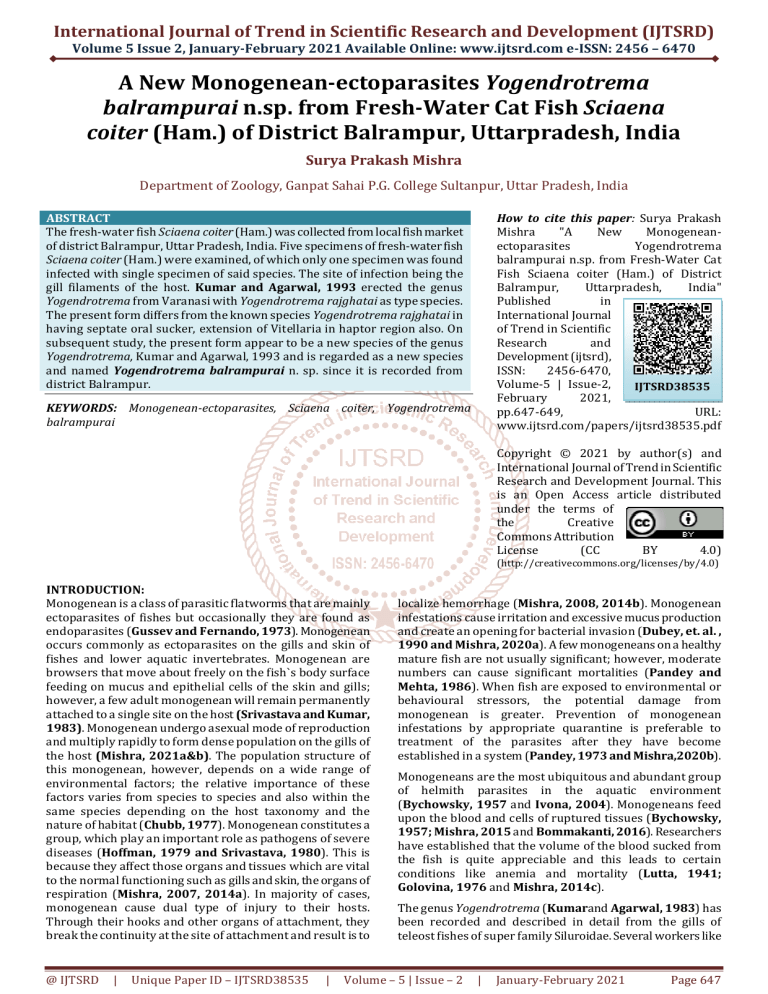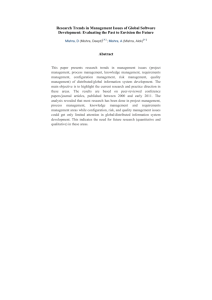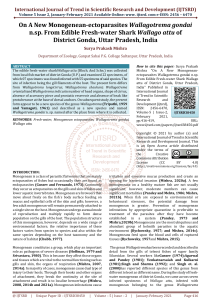
International Journal of Trend in Scientific Research and Development (IJTSRD)
Volume 5 Issue 2, January-February 2021 Available Online: www.ijtsrd.com e-ISSN: 2456 – 6470
A New Monogenean-ectoparasites Yogendrotrema
balrampurai n.sp. from Fresh-Water Cat Fish Sciaena
coiter (Ham.) of District Balrampur, Uttarpradesh, India
Surya Prakash Mishra
Department of Zoology, Ganpat Sahai P.G. College Sultanpur, Uttar Pradesh, India
ABSTRACT
The fresh-water fish Sciaena coiter (Ham.) was collected from local fish market
of district Balrampur, Uttar Pradesh, India. Five specimens of fresh-water fish
Sciaena coiter (Ham.) were examined, of which only one specimen was found
infected with single specimen of said species. The site of infection being the
gill filaments of the host. Kumar and Agarwal, 1993 erected the genus
Yogendrotrema from Varanasi with Yogendrotrema rajghatai as type species.
The present form differs from the known species Yogendrotrema rajghatai in
having septate oral sucker, extension of Vitellaria in haptor region also. On
subsequent study, the present form appear to be a new species of the genus
Yogendrotrema, Kumar and Agarwal, 1993 and is regarded as a new species
and named Yogendrotrema balrampurai n. sp. since it is recorded from
district Balrampur.
How to cite this paper: Surya Prakash
Mishra
"A
New
Monogeneanectoparasites
Yogendrotrema
balrampurai n.sp. from Fresh-Water Cat
Fish Sciaena coiter (Ham.) of District
Balrampur,
Uttarpradesh,
India"
Published
in
International Journal
of Trend in Scientific
Research
and
Development (ijtsrd),
ISSN:
2456-6470,
Volume-5 | Issue-2,
IJTSRD38535
February
2021,
pp.647-649,
URL:
www.ijtsrd.com/papers/ijtsrd38535.pdf
KEYWORDS: Monogenean-ectoparasites, Sciaena coiter, Yogendrotrema
balrampurai
Copyright © 2021 by author(s) and
International Journal of Trend in Scientific
Research and Development Journal. This
is an Open Access article distributed
under the terms of
the
Creative
Commons Attribution
License
(CC
BY
4.0)
(http://creativecommons.org/licenses/by/4.0)
INTRODUCTION:
Monogenean is a class of parasitic flatworms that are mainly
ectoparasites of fishes but occasionally they are found as
endoparasites (Gussev and Fernando, 1973). Monogenean
occurs commonly as ectoparasites on the gills and skin of
fishes and lower aquatic invertebrates. Monogenean are
browsers that move about freely on the fish`s body surface
feeding on mucus and epithelial cells of the skin and gills;
however, a few adult monogenean will remain permanently
attached to a single site on the host (Srivastava and Kumar,
1983). Monogenean undergo asexual mode of reproduction
and multiply rapidly to form dense population on the gills of
the host (Mishra, 2021a&b). The population structure of
this monogenean, however, depends on a wide range of
environmental factors; the relative importance of these
factors varies from species to species and also within the
same species depending on the host taxonomy and the
nature of habitat (Chubb, 1977). Monogenean constitutes a
group, which play an important role as pathogens of severe
diseases (Hoffman, 1979 and Srivastava, 1980). This is
because they affect those organs and tissues which are vital
to the normal functioning such as gills and skin, the organs of
respiration (Mishra, 2007, 2014a). In majority of cases,
monogenean cause dual type of injury to their hosts.
Through their hooks and other organs of attachment, they
break the continuity at the site of attachment and result is to
@ IJTSRD
|
Unique Paper ID – IJTSRD38535
|
localize hemorrhage (Mishra, 2008, 2014b). Monogenean
infestations cause irritation and excessive mucus production
and create an opening for bacterial invasion (Dubey, et. al. ,
1990 and Mishra, 2020a). A few monogeneans on a healthy
mature fish are not usually significant; however, moderate
numbers can cause significant mortalities (Pandey and
Mehta, 1986). When fish are exposed to environmental or
behavioural stressors, the potential damage from
monogenean is greater. Prevention of monogenean
infestations by appropriate quarantine is preferable to
treatment of the parasites after they have become
established in a system (Pandey, 1973 and Mishra,2020b).
Monogeneans are the most ubiquitous and abundant group
of helmith parasites in the aquatic environment
(Bychowsky, 1957 and Ivona, 2004). Monogeneans feed
upon the blood and cells of ruptured tissues (Bychowsky,
1957; Mishra, 2015 and Bommakanti, 2016). Researchers
have established that the volume of the blood sucked from
the fish is quite appreciable and this leads to certain
conditions like anemia and mortality (Lutta, 1941;
Golovina, 1976 and Mishra, 2014c).
The genus Yogendrotrema (Kumarand Agarwal, 1983) has
been recorded and described in detail from the gills of
teleost fishes of super family Siluroidae. Several workers like
Volume – 5 | Issue – 2
|
January-February 2021
Page 647
International Journal of Trend in Scientific Research and Development (IJTSRD) @ www.ijtsrd.com eISSN: 2456-6470
Jain (1957); Tripathi (1959); Achmerow (1964);
Rajeshwari and Kulkarni (1983);Gussev (1974); Kumar
and Agarwal, (1977) and Singh, et. al., (1992) has
reported different species of this genus from different teleost
as different name(Maurya and Agarwal, 2007). During the
study of fresh-water monogenean of district Balrampur, we
came across single infected specimen of Wallago attu,
infected with monogenean belonging to the genus
Yogendrotrema (Achmerow, 1964 and Gussev, 1974). On
subsequent study, the present form appears new to us and
described here in as such.
MATERIAL AND METHODS:
The fishes for the present investigation were collected from
fresh-water bodies and local fish market of district
Balrampur, Uttar Pradesh, India. The monogenean were
collected by Mizelle`s freezing techniques. They were kept
in refrigerator for 8 to 48 hours. The low temperature not
only relaxes the worm but also help in automatic removal of
mucus in which there flukes were entangled. Subsequently,
the gills were removed, placed in separate tubes, half filled
with water and shake vigorously. This solution now poured
in clean petri-dish diluted with water and examined under
binocular microscope. The worms thus collected were
washed and fixed in hot 70% ethyl alcohol or 10% neutral
formalin. Study of chitinoid hard parts were made in either
temporary (glycerin) or permanent preparations. Permanent
preparations were made after dehydrating through
ascending grades of alcohol, clearing in xylene and mounting
in Canada balsam. Camera Lucida sketches were made from
permanent preparations within a week since the stain fades
away in ten days.
GENERIC DIAGNOSIS:
Body elongate, haptor with 22 pairs of clamps in two
symmetrical rows. Without caudal anchors. All clamps are
with uniform skeleton, equal in size, margins having
tripartite appearance. Oral suckers oval, pre-pharynx absent,
pharynx small, oval and muscular.
Oesophagus
short,
without
outgrowth. Testes 13 - 15 in
number, post-ovarian. Cirrus and
cirrus sac absent. Genital atrium
armed with 12 radially arranged
spines. Ovary pre-equatorial,
convoluted caeca.
DESCRIPTION:
The body is elongated, tapering at
anterior end, broader at posterior
end and measuring 2.24 - 2.41 *
0.44 - 0.47 mm. The head is
provided with a pair of muscular,
oval suckers which are septate,
oval and measures 0.041 - 0.043 *
0.060 - 0.062 mm. The septa are
lateral to the centre. The pharynx
is elongated, oval, muscular, well
developed and measures 0.054 0.056 * 0.035 - 0.036 mm.
Intestinal caeca are simple,
bifurcated and terminate blindly
at the posterior region of the body
anterior to the haptor. At the outer
margins the intestinal caeca gives
off numerous blind branches throughout the length except
posterior part.
@ IJTSRD
|
Unique Paper ID – IJTSRD38535
|
The testes are round to oval, post-ovarian, post-equatorial,
inter-caecal, 13 - 16 in numbers and measures 0.031 - 0.050
* 0.021 - 0.060 mm. A ’?’ shaped vas-deferens arises from the
anterior region of the testis and proceeds anteriorly. The
genital atrium is muscular cup like structure, measuring
0.030 - 0.032 mm in diameter. The genital atrium is armed
with 12 radially arranged spines. Each spine has broad base
and pointed tip.
The ovary is pre-equatorial, pre-testicular and measures
0.47 - 0.50 * 0.053 - 0.10 mm. Vitelline follicles extend from
behind the pharynx up to haptor. The haptor is triangular in
shape and measures 0.61 - 0.65 * 0.24 - 0.27 mm. The haptor
contains two rows of clamps and each has 21 clamps. The
clamps are microcotylid type and each measure 0.05 - 0.07
mm in diameter.
Prevalence: One specimen from a single host out of five
examined.
DISCUSSION:
Kumar and Agarwal, 1983 erected the genus
Yogendrotrema for the worms collected from Rhinomugil
corsula from Varanasi with Yogendrotrema rajghatai as type
species. The present form belongs to the Genus
Yogendrotrema, Kumar and Agarwal, 1983.
The known species of the genus is only one i.e.,
Yogendrotrema rajghatai. The present form differs from the
known species in having septate oral sucker, extension of
Vitellaria in haptor region also. On the basis of these, it is
regarded as a new species and named Yogendrotrema
balrampurai n. sp. since collected from district Balrampur,
Uttar Pradesh, India.
REFERENCES:
[1] Achmerow, A. K. (1964): Evolution of the middle
attachment apparatus in the monogenean suborderDactylogyrus. Trudy gelmint. Lab. 14: 69-79.
[2]
Bommakanti, L. (2016): Prevalence of Gyrodactylus
sp. in Channa punctatus (Bloch, 1793) Monogenean
Ecto-parasite Family: Gyrodactylidae at Lower Manair
Dam. Int. J. Curr. Microbiol. App. Sci. Vol. 5 (9): 496507.
[3]
Bychowsky, B. E. (1957): Monogeneans their
systematics and phylogeny (Russian) T. Ransl. English
by W.J. Hargis (Ed.), A.I.B., Washington, DC. 626 pp.
[4]
Chubb, D. K. (1977): Seasonal occurrence of
helminthes in freshwater fishes. PartI. Monogenean.
Adv. Parasitol., 15: 133-199.
[5]
Dubey, A., Gupta, A.K. and Agarwal, S. M. (1990):
Studies on monogenean parasites in fresh water
fishes at Raipur, III. Three new species of the genus
Gyrodactylus Nordmann (1832). Ind. J. Helmithzol.,
42: 1-8.
[6]
Gussev, A. V. and Fernando, C. H. (1973):
Dactylogyridae, Monogenoidea, from the stomach of
fishes. Folia Parasitol. 20: 207-212.
[7]
Gussev, A. V. (1974): Fresh water Indian
Monogenoidea. Principles of systematics, analysis of
the world fauna and their evolution. Indian J. Helmith.
25 & 26: 1-241.
[8]
Hoffman, G. L. (1979): Helmith parasite. In: Plumb, I.
A. (ED.) Principal Diseases of Farm-raised Catfish.
Southern Cooperative Series No. 225, pp. 40-58.
Volume – 5 | Issue – 2
|
January-February 2021
Page 648
International Journal of Trend in Scientific Research and Development (IJTSRD) @ www.ijtsrd.com eISSN: 2456-6470
[9]
Ivona, M. (2004): Monogenean parasites in Adriatic
cage-reared fish. Acta Adriatica. 5: 65-73.
[10]
Jain, S. L. (1957): Mizelleus indicus n. gn. (subfamilyTetraonchinae) from the gill filament of Wallagonia
attu (Bloch.) Ann. Zool. Agra. 2: 56-62.
[11]
Kumar, R. and Agarwal, G. P. (1977): On a new
monogenetic trematode Silonditrema tripathi n. sp.
from the gills of a fresh water fish Wallago attu.
Abstract of the 1st National Congress of Parasitology,
Baroda, 24-26 February, 1977: 21.
[12]
[13]
[14]
[15]
[16]
[17]
[18]
Kumar, R. and Agarwal, G. P. (1983): A new
monogenetic trematode Yogendrotrema rajghatai
new genus new species from the gills of a fresh water
fish Rhinomugil corsula. Rivista di Parassitologia Vol.
44 (2): 187 - 192.
Lutta, A. S. (1941): Vospallenie zhabru Acipenser
nudiventris vyzvannoe, monogenetcheskin sosal.
Shchikem Nitzchia sturionis (inflammation of gills of
Acipenser nudiventis caused by the monogenetic
trematode Nitzchia sturionis). Zoology. Zhurnal. 20:
520-527.
Maurya, A. K. and Agarwal, G. P. (2007): On three
new species of the genus Rhinomugilotrema namely
as R. Agarwal sp., R. guptai sp. and R. thapari sp. from
the intestine of a fresh water fish Rhinomugil corsula
(Ham.) at Varanasi, India. Journal of Experimental
Zoology India 10 (1): 189 - 194.
Mishra, Surya Prakash (2007): A new monogenean,
Ancylodiscoides amethii, n. sp. from fresh water fish
Notopterus notopterus. J. Liv. World Vol. 14 (1): 1317.
Mishra, S. P. and Pande, P. N. (2008): A new
monogenean MetahaliotremaTripathi n. sp. from fresh
water fish Rita rita (Ham.).J.PAS Zoological Sciences
Vol. 14: 40-45.
Mishra, Surya Prakash (2014a): A new Monogenea
Diclidophora srivastavai n. sp. from fresh water fish
Setipinna phasa. Int. J. Curr. Microbiol. App. Sci. Vol. 3
(12): 201-204.
Mishra, Surya Prakash (2014b): A new
monogenean Hamatopeduncularia saketensis n. sp.
from fresh water fish Wallago attu. Int. J. Multidis.
Res. Dev. Vol. 1 (7): 244-246.
from Indian fresh water food fish Cirrhinus mrigala.
Int. J. Fish. Aqua. Stud. Vol. 2 (4): 140-141.
[21]
Mishra, Surya Prakash (2020a): Monogenetic
Trematode Infestations in Indian Cat Fishes of River
Gomti at District Sultanpur, Uttar Pradesh, India. Int. J.
Modern. Trends in Science and Technology. Vol. 6 (8):
120-124.
[22]
Mishra, Surya Prakash (2020b): Monogenetic
trematode infestations in Indian major carps of
Ayodhya division, Uttar Pradesh, India. J. Emer. Tech.
Innov. Res. Vol. 7 (7): 1920-1928.
[23]
Mishra, Surya Prakash (2021a): On a New
Ectoparasitic Monogenea Rhamnocercus chauhani n.
sp. From Gills of Fresh-water Fish Wallago attu of
District Siddharth Nagar, Uttar Pradesh, India.
International Journal of All Education and Scientific
Methods (IJARESM), Vol. 9 (1): 507 - 510.
[24]
Mishra, Surya Prakash (2021b): A New
Monogenean-ectoparasites Silurodescoides srivastavai
n. sp. From Edible Fresh-water Cat Fish Wallago attu
of District Balrampur, Uttar Pradesh, India.
International Journal for Modern Trends in Science
and Technology, Vol. 7 (01): 65 - 68. DOI:
https://doi.org/10.46501/IJMTST070114.
[25]
Pandey, K. C. (1973): Studies on the monogenetic
trematodes of India III. On a new species of Diplozoon
Nordmann, 1822 from Catla catla (Ham.). Indian J.
Zool. Vol. 14: 147-148.
[26]
Pandey, K. C. and Mehta, T. (1986): Studies on some
new monogenetic trematode of Wallago attu (Bloch.)
at Meerut, Uttar Pradesh, India. Proc. 2nd Nat. Conv.
Young Scientists. 114-132.
[27]
Rajeshwari, J. S. and Kulkarni, T. (1983): On a new
species of Bychowskyella singhi from the gills of fresh
water fish Wallago attu from Hyderabad, A.P., India.
Proc. Indian Acad. Parasitol. Vol. 4: 49-53.
[28]
Singh, H. S.; Kumari, M. and Agarwal, S. (1992): On
some known and unknown Monogeneans from
Wallago attu (Bloch. And Schn.) Functional and
Developmental Morphology. Vol. 2: 85-88.
[29]
Srivastava, C. B. (1980): Estimation of helminthic
infections. Proceedings Workshop Technology
Parasitol. Zool. Survey of India, pp. 29-31.
[19]
Mishra, Surya Prakash (2014c): A New Monogenea
Paramazocraes nawabganjensis n. sp. from fresh
water fish Eutropichthyes vacha. Int. J. Eng. Sci. Inv.
Res. Dev. Vol. 1 (5): 190-193.
[30]
Srivastava, J. K. and Kumar, R. (1983): On a new
monogenetic trematode Labotrema rajendrai n. sp.
from the gills of a fresh water fish Gara gotyla (Gray).
Indian J. Forestry, 6 (4): 330 - 331.
[20]
Mishra, Surya Prakash (2015): On a new species of
Monogenea Diplozoon chauhani n. sp. (Diplozooidae)
[31]
Tripathi, Y. R. (1959): Monogenetic trematodes of
fishes from India. Indian J. Helmith. Vol. 9: 1- 149.
@ IJTSRD
|
Unique Paper ID – IJTSRD38535
|
Volume – 5 | Issue – 2
|
January-February 2021
Page 649







